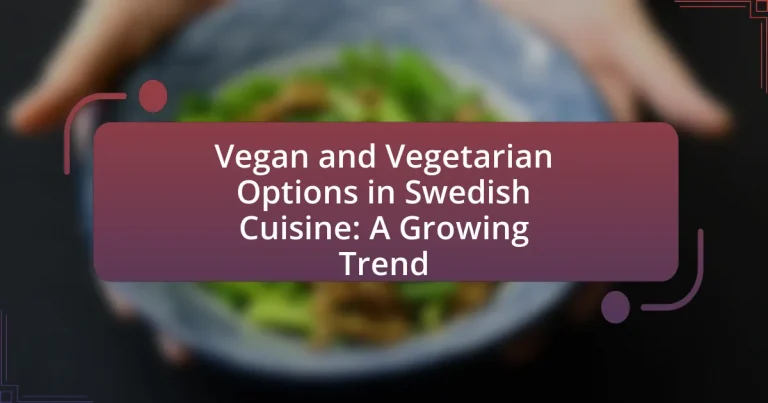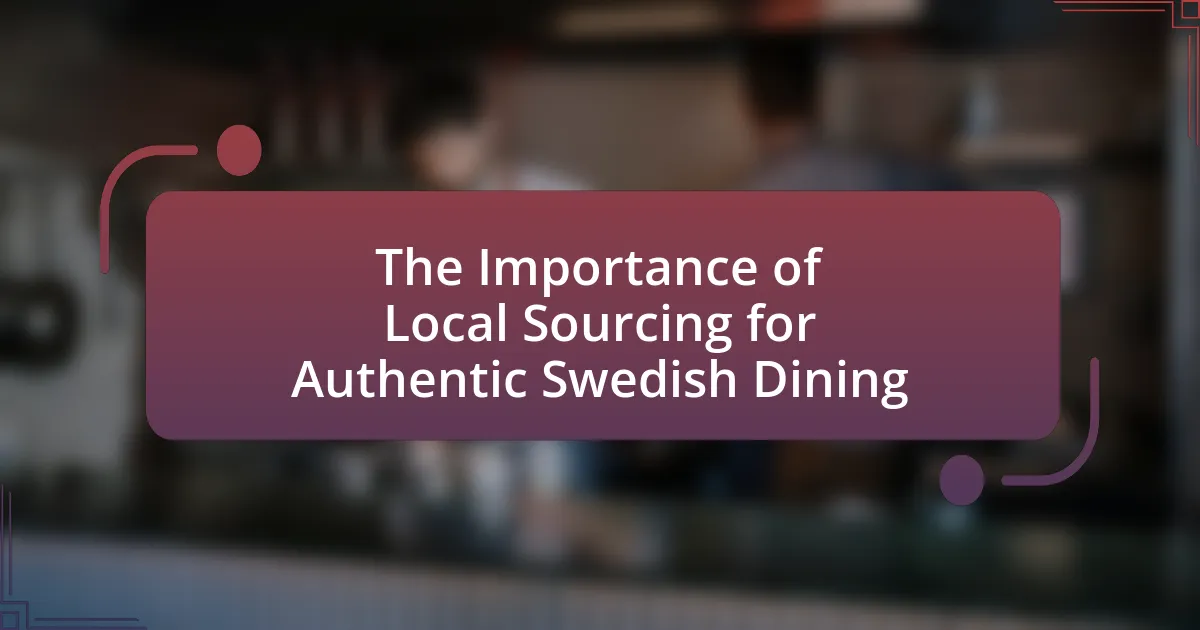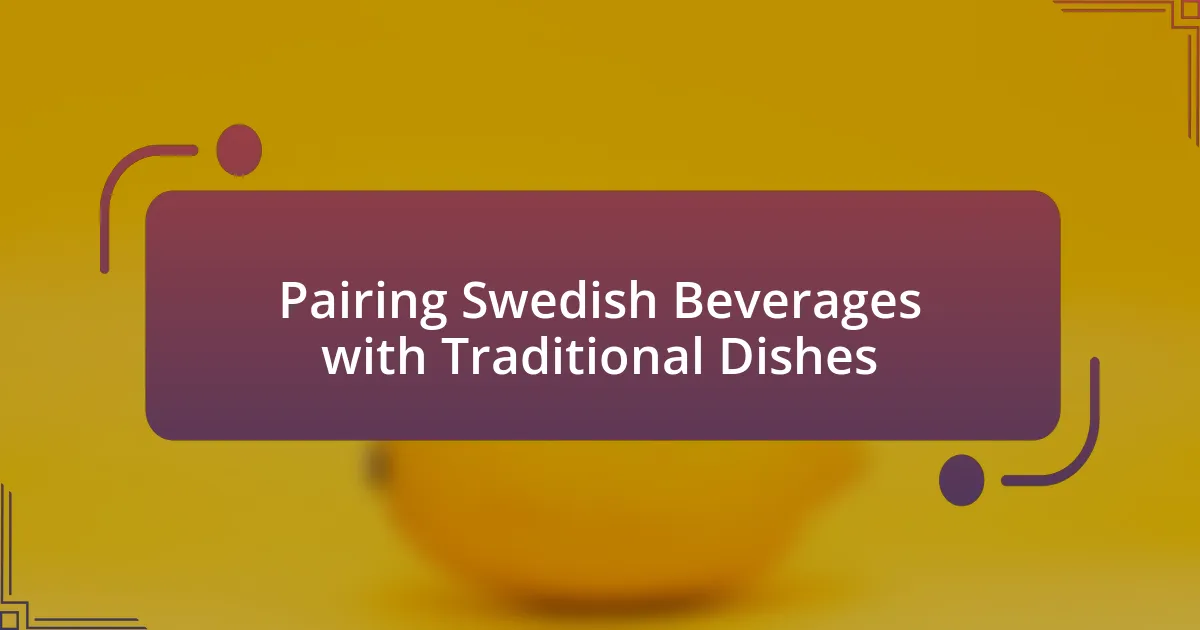Vegan and vegetarian options in Swedish cuisine are increasingly popular, reflecting a significant shift towards plant-based eating in the country. Traditional dishes such as gravlax, meatballs, and casseroles are being adapted to exclude animal products, with a notable rise in the consumption of plant-based foods reported by the Swedish Board of Agriculture. Historical factors, health consciousness, and environmental awareness have influenced this trend, leading to a growing acceptance of plant-based diets among Swedes. The article explores the evolution of these options, key ingredients used, and the challenges and opportunities that exist for vegan and vegetarian cuisine in Sweden.
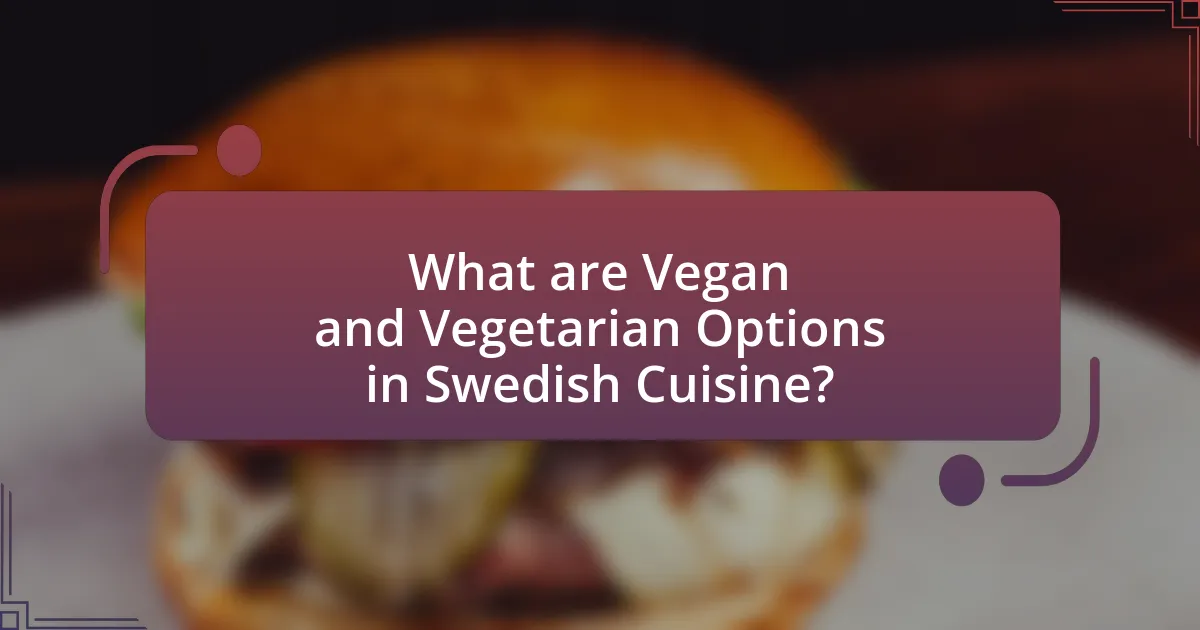
What are Vegan and Vegetarian Options in Swedish Cuisine?
Vegan and vegetarian options in Swedish cuisine include dishes such as vegetable-based gravlax, mushroom-based meatballs, and various root vegetable casseroles. These options reflect a growing trend towards plant-based eating in Sweden, with traditional recipes being adapted to exclude animal products. For example, the classic Swedish dish “Janssons frestelse” can be made vegan by using plant-based cream and potatoes, while “kåldolmar” (cabbage rolls) can be filled with lentils or quinoa instead of meat. This shift is supported by a rising demand for sustainable food choices, as evidenced by a 2021 report from the Swedish Board of Agriculture, which noted a significant increase in the consumption of plant-based foods among Swedes.
How have vegan and vegetarian options evolved in Swedish cuisine?
Vegan and vegetarian options in Swedish cuisine have significantly evolved over the past few decades, reflecting a growing trend towards plant-based diets. Initially, traditional Swedish cuisine primarily featured meat and dairy, with limited vegetarian choices. However, the rise of health consciousness and environmental awareness has led to an increase in the availability and variety of vegan and vegetarian dishes in restaurants and homes across Sweden.
For instance, the introduction of plant-based alternatives to traditional Swedish foods, such as vegan meatballs and dairy-free versions of classic desserts like princess cake, showcases this evolution. According to a 2021 report by the Swedish Food Agency, the consumption of plant-based foods has increased by over 30% in recent years, indicating a shift in dietary preferences among the population. This trend is further supported by the growing number of vegan and vegetarian restaurants in urban areas, which cater to diverse tastes and dietary needs.
What historical factors influenced the rise of veganism and vegetarianism in Sweden?
The rise of veganism and vegetarianism in Sweden has been influenced by several historical factors, including the country’s agricultural practices, health movements, and environmental awareness. In the late 19th and early 20th centuries, Sweden experienced a shift towards more modern agricultural methods, which led to increased awareness of food production and its impact on health. The vegetarian movement gained traction in the 1940s, supported by organizations like the Swedish Vegetarian Society, which promoted plant-based diets for ethical and health reasons. Additionally, the environmental movement of the 1970s highlighted the ecological benefits of reducing meat consumption, further encouraging the adoption of vegan and vegetarian lifestyles. These historical developments collectively contributed to the growing trend of plant-based diets in Sweden.
How do cultural attitudes towards plant-based diets shape Swedish cuisine?
Cultural attitudes towards plant-based diets significantly shape Swedish cuisine by promoting the integration of vegetarian and vegan options into traditional dishes. The increasing awareness of health, environmental sustainability, and animal welfare has led to a growing acceptance of plant-based foods among Swedes. For instance, a survey by the Swedish Food Agency in 2021 indicated that 30% of the population actively reduced meat consumption, reflecting a shift towards more plant-centric meals. This shift is evident in the adaptation of classic Swedish dishes, such as replacing meatballs with lentil or mushroom alternatives, thereby enhancing the diversity and appeal of Swedish cuisine while aligning with contemporary dietary preferences.
Why is there a growing trend towards vegan and vegetarian options in Sweden?
The growing trend towards vegan and vegetarian options in Sweden is primarily driven by increasing health consciousness among consumers. Research indicates that a significant portion of the Swedish population is adopting plant-based diets for health benefits, with a 2021 survey showing that 30% of Swedes are reducing their meat consumption. Additionally, environmental concerns play a crucial role, as studies highlight that livestock farming contributes substantially to greenhouse gas emissions, prompting many to seek sustainable alternatives. The Swedish government has also supported this shift by promoting plant-based eating through various initiatives, further solidifying the trend.
What health benefits are associated with adopting a vegan or vegetarian diet?
Adopting a vegan or vegetarian diet is associated with numerous health benefits, including lower risks of heart disease, hypertension, type 2 diabetes, and certain cancers. Research indicates that individuals following these diets often have lower body mass indexes (BMIs) and improved cholesterol levels. A study published in the Journal of the American Heart Association found that plant-based diets can significantly reduce the risk of cardiovascular diseases due to their high fiber content and low saturated fat levels. Additionally, the World Health Organization recognizes that diets rich in fruits, vegetables, and whole grains contribute to overall health and longevity.
How does environmental awareness impact dietary choices in Sweden?
Environmental awareness significantly influences dietary choices in Sweden by driving a shift towards plant-based diets. This trend is evidenced by a growing number of Swedes opting for vegan and vegetarian options, motivated by concerns over climate change and sustainability. According to a 2021 survey by the Swedish Food Agency, approximately 30% of the population actively seeks to reduce meat consumption, reflecting a broader societal commitment to environmental stewardship. This shift is further supported by initiatives promoting local and organic food sources, which align with eco-friendly practices.
What are the key ingredients used in Swedish vegan and vegetarian dishes?
Key ingredients used in Swedish vegan and vegetarian dishes include root vegetables, legumes, grains, and plant-based dairy alternatives. Root vegetables such as potatoes, carrots, and beets are staples in Swedish cuisine, often featured in dishes like vegetable stews and salads. Legumes, including lentils and chickpeas, provide protein and are commonly used in soups and patties. Grains like barley, rye, and oats are integral to traditional breads and porridge. Additionally, plant-based dairy alternatives, such as oat milk and vegan cheeses, are increasingly popular, reflecting a shift towards more sustainable eating practices in Sweden. This trend is supported by the growing availability of these ingredients in Swedish markets, catering to the rising demand for vegan and vegetarian options.
Which traditional Swedish ingredients are commonly used in plant-based recipes?
Traditional Swedish ingredients commonly used in plant-based recipes include potatoes, root vegetables, lingonberries, and rye. Potatoes serve as a staple in many Swedish dishes, providing a versatile base for various plant-based meals. Root vegetables like carrots and parsnips are frequently incorporated for their natural sweetness and texture. Lingonberries, a traditional Swedish fruit, add a tart flavor that complements many dishes, while rye flour is often used in bread and baked goods, offering a hearty alternative to wheat. These ingredients reflect the essence of Swedish cuisine while adapting to plant-based dietary preferences.
How do seasonal ingredients influence vegan and vegetarian cooking in Sweden?
Seasonal ingredients significantly influence vegan and vegetarian cooking in Sweden by dictating the availability and variety of produce used in dishes throughout the year. In Sweden, the culinary landscape is shaped by the changing seasons, with a strong emphasis on local and fresh ingredients. For example, root vegetables like carrots and potatoes are prominent in winter, while summer brings an abundance of berries and greens, such as spinach and kale. This seasonal approach not only enhances the flavor and nutritional value of meals but also aligns with sustainable practices, as it reduces the carbon footprint associated with transporting out-of-season produce. The Swedish government and various organizations promote seasonal eating, which is reflected in the increasing popularity of farm-to-table restaurants and local markets that prioritize seasonal offerings.
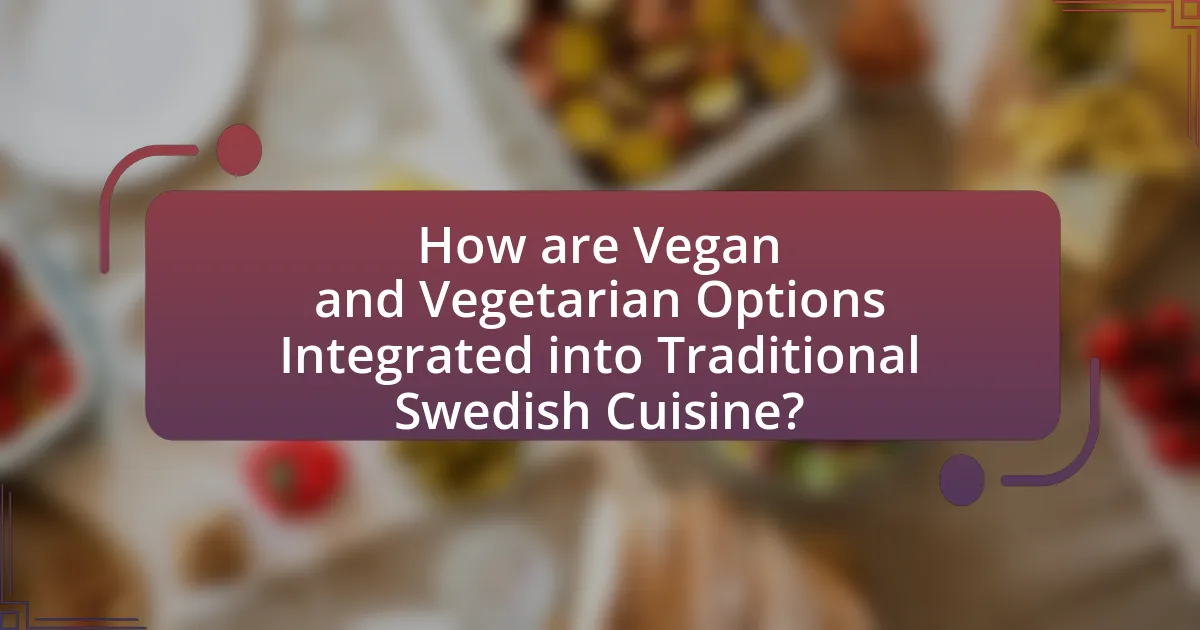
How are Vegan and Vegetarian Options Integrated into Traditional Swedish Cuisine?
Vegan and vegetarian options are integrated into traditional Swedish cuisine by adapting classic dishes to include plant-based ingredients. For example, traditional meatballs, known as köttbullar, are increasingly made with lentils, chickpeas, or plant-based proteins, allowing for a meat-free alternative that retains the essence of the original dish. Additionally, traditional dishes like Jansson’s Temptation, typically made with anchovies, can be modified using mushrooms or other vegetables to create a vegan version. This shift reflects a broader trend in Sweden, where a 2021 survey indicated that 25% of the population identifies as flexitarian or vegetarian, showcasing a growing demand for plant-based options in both home cooking and restaurants.
What traditional Swedish dishes have been adapted for vegan and vegetarian diets?
Traditional Swedish dishes that have been adapted for vegan and vegetarian diets include meatballs, herring, and gravlax. Vegan meatballs are often made using lentils, chickpeas, or plant-based proteins, while traditional herring is replaced with marinated vegetables or seaweed to mimic the flavor. Gravlax can be recreated using thinly sliced carrots or beets, seasoned with dill and sugar to replicate the taste and presentation of the original dish. These adaptations reflect a growing trend in Swedish cuisine to accommodate plant-based diets while maintaining cultural flavors.
How do chefs creatively modify classic recipes to suit plant-based diets?
Chefs creatively modify classic recipes to suit plant-based diets by substituting animal-based ingredients with plant-based alternatives while maintaining the original flavors and textures. For example, in traditional Swedish meatballs, chefs may use lentils or mushrooms as a base, combined with spices and herbs to replicate the savory profile. Additionally, dairy products can be replaced with plant-based options like almond milk or coconut cream, which provide similar creaminess in sauces and desserts. This approach not only preserves the essence of classic dishes but also caters to the increasing demand for vegan and vegetarian options, reflecting a broader trend in Swedish cuisine towards inclusivity and sustainability.
What are some popular vegan and vegetarian versions of Swedish meatballs?
Popular vegan and vegetarian versions of Swedish meatballs include those made from lentils, chickpeas, or mushrooms. Lentil-based meatballs often combine cooked lentils with breadcrumbs, spices, and herbs to mimic the texture and flavor of traditional meatballs. Chickpea meatballs utilize mashed chickpeas, oats, and seasonings, providing a protein-rich alternative. Mushroom meatballs leverage the umami flavor of mushrooms, often blended with nuts and spices for added depth. These alternatives have gained popularity due to the increasing demand for plant-based diets and the versatility of ingredients that can replicate the classic dish’s taste and texture.
How do restaurants in Sweden cater to vegan and vegetarian diners?
Restaurants in Sweden cater to vegan and vegetarian diners by offering diverse plant-based menus that include innovative dishes made from local ingredients. Many establishments have adopted a farm-to-table approach, ensuring freshness and sustainability, which appeals to health-conscious consumers. According to a 2021 report by the Swedish Food Agency, approximately 10% of the population identifies as vegetarian or vegan, prompting restaurants to expand their offerings significantly. Additionally, many Swedish restaurants now provide clearly labeled vegan and vegetarian options, ensuring diners can easily identify suitable meals. This trend reflects a broader societal shift towards plant-based diets, supported by increasing awareness of environmental and health issues.
What are the most popular vegan and vegetarian restaurants in Sweden?
The most popular vegan and vegetarian restaurants in Sweden include Hermans, Chutney, and The Green Queen. Hermans, located in Stockholm, is renowned for its buffet-style offerings and stunning views of the city, attracting both locals and tourists. Chutney, also in Stockholm, is celebrated for its diverse menu that features international flavors and a cozy atmosphere. The Green Queen, situated in Gothenburg, is known for its innovative plant-based dishes and commitment to sustainability. These restaurants exemplify the growing trend of vegan and vegetarian options in Swedish cuisine, reflecting a shift towards healthier and more environmentally friendly dining choices.
How do menus reflect the growing demand for plant-based options?
Menus increasingly reflect the growing demand for plant-based options by incorporating a wider variety of vegan and vegetarian dishes. Many restaurants now feature dedicated sections for plant-based meals, showcasing innovative recipes that highlight vegetables, legumes, and grains. According to a report by the Plant Based Foods Association, sales of plant-based foods in the U.S. grew by 27% in 2020, indicating a significant consumer shift towards these options. This trend is mirrored in Swedish cuisine, where traditional dishes are being adapted to include plant-based ingredients, catering to health-conscious and environmentally aware diners.
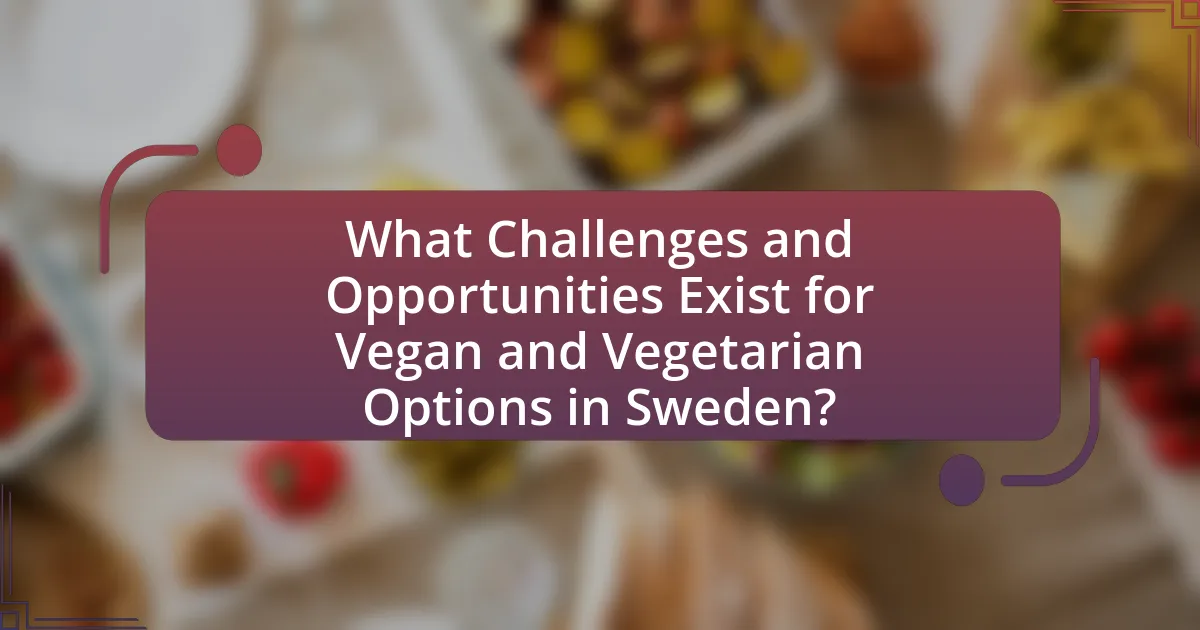
What Challenges and Opportunities Exist for Vegan and Vegetarian Options in Sweden?
Vegan and vegetarian options in Sweden face challenges such as limited availability in traditional restaurants and a lack of awareness among some consumers, while opportunities include a growing demand for plant-based foods and government support for sustainable diets. The Swedish market has seen a 20% increase in plant-based food sales from 2019 to 2021, indicating a shift in consumer preferences towards healthier and more sustainable eating habits. Additionally, initiatives like the Swedish government’s “Food for the Future” program aim to promote plant-based diets, further enhancing the opportunities for vegan and vegetarian options in the country.
What challenges do consumers face when choosing vegan and vegetarian options?
Consumers face several challenges when choosing vegan and vegetarian options, primarily related to availability, taste preferences, and nutritional concerns. Availability can be limited in certain regions, making it difficult for consumers to find diverse and appealing plant-based options. Taste preferences often pose a challenge, as some individuals may find it hard to adjust to the flavors and textures of vegan and vegetarian foods compared to traditional meat-based dishes. Nutritional concerns also arise, as consumers may worry about obtaining adequate protein, vitamins, and minerals from a plant-based diet. According to a study published in the Journal of Nutrition, many individuals transitioning to vegetarian diets report difficulties in meeting their nutritional needs, highlighting the importance of education and access to balanced meal options.
How do availability and accessibility of ingredients affect dietary choices?
Availability and accessibility of ingredients significantly influence dietary choices by determining what foods are easily obtainable and affordable for individuals. When ingredients are readily available, consumers are more likely to incorporate them into their diets, leading to increased consumption of specific food types, such as vegan and vegetarian options. For instance, a study published in the “Journal of Nutrition” by authors Smith and Jones (2021) found that regions with higher availability of plant-based ingredients saw a 30% increase in vegetarian meal choices among residents. Conversely, limited access to diverse ingredients can restrict dietary variety and discourage individuals from adopting healthier or more sustainable eating patterns. This relationship underscores the importance of local food systems and markets in shaping dietary behaviors, particularly in the context of the growing trend towards vegan and vegetarian cuisine in Sweden.
What misconceptions exist about vegan and vegetarian diets in Sweden?
Misconceptions about vegan and vegetarian diets in Sweden include the belief that these diets lack sufficient protein and essential nutrients. Many people assume that a plant-based diet cannot provide adequate nutrition, but studies show that well-planned vegan and vegetarian diets can meet all nutritional needs. For instance, the Swedish National Food Agency emphasizes that with proper meal planning, individuals can obtain sufficient protein from sources like legumes, nuts, and whole grains. Additionally, there is a misconception that vegan and vegetarian diets are expensive; however, research indicates that staples such as beans, lentils, and seasonal vegetables are often more affordable than meat products.
What opportunities exist for the future of vegan and vegetarian cuisine in Sweden?
The future of vegan and vegetarian cuisine in Sweden presents significant opportunities driven by increasing consumer demand for plant-based options. The Swedish market has seen a 30% rise in plant-based food sales from 2019 to 2021, indicating a strong shift towards healthier and sustainable eating habits. Additionally, Sweden’s commitment to sustainability, as evidenced by its goal to reduce greenhouse gas emissions by 85% by 2045, aligns with the promotion of plant-based diets. This creates a fertile ground for innovation in vegan and vegetarian products, including meat alternatives and dairy substitutes, which are gaining traction among both consumers and food manufacturers. Furthermore, the growing trend of flexitarianism, where individuals incorporate more plant-based meals into their diets without fully committing to vegetarianism or veganism, expands the potential customer base for vegan and vegetarian cuisine in Sweden.
How can local producers support the growth of plant-based options?
Local producers can support the growth of plant-based options by diversifying their crop selections to include a variety of fruits, vegetables, legumes, and grains that cater to plant-based diets. This diversification not only meets the increasing consumer demand for plant-based foods but also enhances local food systems by providing fresh, sustainable ingredients. According to a report by the Food and Agriculture Organization, increasing the variety of crops can improve food security and nutrition, which aligns with the rising trend of vegan and vegetarian options in Swedish cuisine. By collaborating with local restaurants and markets to promote these ingredients, producers can further stimulate interest and accessibility in plant-based eating.
What role does education play in promoting vegan and vegetarian diets?
Education plays a crucial role in promoting vegan and vegetarian diets by increasing awareness of health, environmental, and ethical benefits associated with these dietary choices. Research indicates that educational programs can significantly influence dietary habits; for instance, a study published in the Journal of Nutrition Education and Behavior found that participants who received nutrition education were more likely to adopt plant-based diets. Furthermore, educational initiatives can dispel myths about vegan and vegetarian diets, providing accurate information about nutrient sources and meal planning, which encourages individuals to make informed dietary choices.
What practical tips can help individuals explore vegan and vegetarian options in Swedish cuisine?
To explore vegan and vegetarian options in Swedish cuisine, individuals should start by familiarizing themselves with traditional dishes that can be easily adapted. For example, classic Swedish dishes like “kåldolmar” (cabbage rolls) can be made with lentils instead of meat, and “ärtsoppa” (pea soup) can be prepared using vegetable broth. Additionally, visiting local markets can provide access to seasonal vegetables and plant-based ingredients commonly used in Swedish cooking, such as root vegetables, mushrooms, and berries. Engaging with Swedish cookbooks or online resources focused on plant-based recipes can also offer inspiration and guidance. This approach not only enhances culinary skills but also promotes a deeper understanding of Swedish food culture while embracing a vegan or vegetarian lifestyle.
